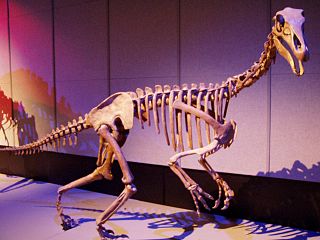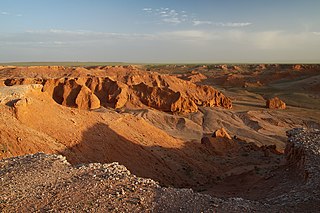
Alectrosaurus is a genus of tyrannosauroid theropod dinosaur that lived in Asia during the Late Cretaceous period, about some 96 million years ago in what is now the Iren Dabasu Formation.

Alxasaurus is a genus of therizinosauroid theropod dinosaurs from the Early Cretaceous Bayin-Gobi Formation of Inner Mongolia. They are some of the earliest known members of the Therizinosauroidea, but they already possessed the body shape—including the long neck, short tail, and relatively large claws—of later therizinosauroids. Like other members of this group, it was a bipedal herbivore with a large gut to process plant material. Several specimens are known and they vary in size.

The Djadochta Formation is a highly fossiliferous geological formation situated in Central Asia, Gobi Desert, dating from the Late Cretaceous period, about 75 million to 71 million years ago. The type locality is the Bayn Dzak locality, famously known as the Flaming Cliffs. Dinosaur, mammal, and other reptile remains are among the fossils that have been recovered from the formation.

Estesia is an extinct genus of Late Cretaceous anguimorph lizard found in the Gobi Desert in Mongolia. It was discovered in June 1990 by a joint expedition made up of Mongolian and American palaeontologists, and described in 1992 by Mark Norell, Malcolm McKenna and Michael Novacek. This animal is of interest to palaeontologists, not only because it is close to the lineage of modern Gila monsters (Heloderma), but also because its dentition shows evidence that it was venomous.
Isodontosaurus is an extinct genus of iguanian lizard from the Late Cretaceous of Mongolia and China. The type species is Isodontosaurus gracilis. Isodontosaurus is part of an extinct group of Late Cretaceous iguanians called Gobiguania, which is currently thought to be endemic to Mongolia.
Aiolosaurus is an extinct genus of monitor lizard from the Late Cretaceous of Mongolia. The type and only species, Aiolosaurus oriens, was named in 2000 from Ukhaa Tolgod, a rich fossil site in the Campanian-age Djadochta Formation.
Cherminotus is an extinct genus of monitor lizard from the Late Cretaceous of Mongolia. The type and only species, Cherminotus longifrons, was named in 1984.
Telmasaurus is an extinct genus of varanoid lizard from the Late Cretaceous of Mongolia. Fossils have been found from the Djadokha and Barun Goyot Formations that date between the early and middle Campanian stage from approximately 80 to 75 million years ago. The type species Telmasaurus grangeri was named in 1943.
Proplatynotia is an extinct genus of varanoid lizard from the Late Cretaceous of Mongolia. Fossils have been found in the Barun Goyot Formation, which is mid-Campanian in age. The type and only species, P. longirostratia, was named in 1984.
Gobiguania is an extinct clade of iguanian lizards from the Late Cretaceous. All known gobiguanians are endemic to the Gobi Desert of Mongolia. Gobiguania was given a phylogenetic definition by Jack Conrad and Mark Norell in 2007 as all taxa more closely related to Anchaurosaurus gilmorei than to Iguana iguana, Crotaphytus collaris, or Agama agama. According to Conrad and Norell's phylogenetic analysis, Gobiguania includes Anchaurosaurus as well as several other Late Cretaceous lizards such as Ctenomastax, Temujinia, Saichangurvel, and Zapsosaurus. A phylogenetic analysis published in 2012 indicated that three other lizard genera — Igua, Isodontosaurus, and Polrussia, all from Mongolia and all from the Late Cretaceous — are also gobiguanians. Below is a cladogram from the analysis:
Priscagamidae is an extinct family of iguanian lizards known from the Late Cretaceous of Mongolia and China and the Eocene of India, spanning a range from 75 to 54 million years ago. It includes the genera Heterodontagama, Mimeosaurus, Phrynosomimus, Priscagama, and possibly Pleurodontagama. The first fossils of priscagamids were found in the Djadochta and Khermeen Tsav formations of Mongolia. More recently they have been found in the Cambay Formation in India, leading to the naming of Heterodontagama in 2013. Priscagamidae was originally described as a subfamily of Agamidae called Priscagaminae in 1984, but it was reclassified as a distinct family in 1989. Most phylogenetic analyses still find a close relationship between Priscagamidae and Agamidae, although a 2015 study found it to be basal to all other iguanian clades, warranting its removal from Iguania and placement in a larger clade called Iguanomorpha.
Saichangurvel is an extinct genus of iguanian lizards from the Late Cretaceous of Mongolia. It is a member of a clade called Gobiguania, an exclusively Late Cretaceous group of iguanian lizards that was likely endemic to the Gobi Desert. The type species, Saichangurvel davidsoni, was named by paleontologists Jack Conrad and Mark Norell of the American Museum of Natural History in 2007. It is known from a single nearly complete and fully articulated skeleton called IGM 3/858, which was found eroding from a block of sandstone during a thunderstorm at a fossil locality called Ukhaa Tolgod. IGM 3/858 comes from the Djadochta Formation, which is between 75 and 71 million years in age. Just as it is today, the Gobi was a desert during the Cretaceous. IGM 3/858 may have died in a collapsing sand dune, the rapid burial preserving its skeleton in pristine condition.
Pleurodontagama is an extinct genus of iguanian lizard from the Late Cretaceous of Mongolia. The type species, Pleurodontagama aenigmatodes, was named in 1984 on the basis of a mostly complete skull and isolated lower jaw from a fossil locality called Khermeen Tsav. It has a wide skull with a flat snout, large eye sockets, and small bumps on the surfaces of the bones. Pleurodontagama was initially classified in the family Priscagamidae, which is usually grouped in a large clade of iguanians called Acrodonta, members of which are characterized by an "acrodont" dentition in which the teeth grow from the margins of the jaws. However, Pleurodontagama is unusual in that it has a sub-pleurodont dentition, meaning that some of its teeth grow from the inner surfaces of the jaw. There is also evidence to suggest that its teeth may have been continuously replaced throughout life, as opposed to the permanent teeth of acrodontans. Pleurodontagama may have been a transitional form between the derived acrodont type and the pleurodont type inferred for the ancestors of Acrodonta.
Priscagama is an extinct genus of iguanian lizard from the Late Cretaceous of Mongolia and China. It belongs to an extinct family of iguanians called Priscagamidae. Several incomplete skulls have been found in the Barun Goyot and Djadochta formations, and were originally referred to the genus Mimeosaurus; the type species Priscagama gobiensis was named in 1984 when it was recognized that these skulls belonged to a distinct species. Priscagama differs from most other priscagamids in having a more elongate, lightly-built skull. It is very similar in appearance to another priscagamid called Pleurodontagama, as the two can only be distinguished by the shape of their teeth.
Phrynosomimus is an extinct genus of iguanian lizard from the Late Cretaceous of Mongolia belonging to the extinct family Priscagamidae. The type species Phrynosomimus asper was named in 1996. Fossils have been found in the Barun Goyot and Djadochta formations and include several complete skulls. Phrynosomimus has a short, triangular skull with bony spikes projecting from the back, stemming from the squamosal and parietal bones. These spikes give it a similar appearance to the modern horned lizard Phrynosoma and inspire its name, which means "Phrynosoma mimic". Like other priscagamids it has an acrodont dentition, meaning that its teeth grow from the margins of the jaws rather than their inner surfaces, as is the case for the pleurodont dentitions of most lizards.
Anchaurosaurus is an extinct genus of iguanian lizard from the Late Cretaceous of Inner Mongolia, China. It belongs to an extinct clade of iguanians called Gobiguania that was endemic to the Gobi Desert during the Late Cretaceous. The type species, Anchaurosaurus gilmorei, was named in 1995 on the basis of a well-preserved skull and incomplete skeleton from the Djadochta Formation. Compared to other iguanians, Anchaurosaurus has a relatively elongated skull, large eye sockets, and higher tooth crowns. Phylogenetic analysis indicates that among gobiguanians, Anchaurosaurus is most closely related to Zapsosaurus from Mongolia. Below is a cladogram from Daza et al. (2012) showing the phylogenetic relationships of Anchaurosaurus:
Xihaina is an extinct genus of iguanian lizard from the Late Cretaceous of Inner Mongolia, China. The type species Xihaina aquilonia was named in 1995 from the Djadochta Formation and is known from a partial skeleton that preserves parts of the skull, most of the vertebral column, the pelvis, and the right hind limb. The incomplete nature of this specimen makes the classification of Xihaina difficult; it has never been incorporated into a phylogenetic analysis, but it shares similarities with a group of Late Cretaceous Mongolian lizards called Gobiguania, particularly the gobiguanian genera Anchaurosaurus and Polrussia. The fact that many skeletal elements are missing yet the rest of the skeleton is articulated suggests the individual may have been partially eaten by a predator or scavenger and then rapidly buried soon after.
Polrussia is an extinct genus of iguanian lizards dating to the Late Cretaceous epoch, found in what is now Mongolia. It belongs to a group of extinct iguanians called Gobiguania that was endemic to the Gobi Desert during the Late Cretaceous. The type species Polrussia mongoliensis was named in 1991 on the basis of a skull found in the Barun Goyot Formation. The genus name refers to the Polish and Russian paleontologists who worked together to find and describe the material. Polrussia has a short skull, slightly pointed and flattened snout, and large eye sockets. The teeth each have one cusp, as opposed to the multiple cusps seen in some other gobiguanians. The skull is only 1.2 centimetres (0.47 in) long, making Polrussia one of the smallest gobiguanians.

Igua is an extinct genus of iguanian lizards belonging to a group called Gobiguania that was endemic to the Gobi Desert during the Late Cretaceous. The type species Igua minuta was named in 1991 on the basis of a skull from the Barun Goyot Formation in Mongolia. The skull itself is very small, only 14 millimetres (0.55 in) long, and may have belonged to a juvenile given that it possesses a large fontanelle and that many of the bones are unfused. The snout-vent length of the individual is estimated to have been 55 to 65 millimetres. Igua differs from related gobiguanians like Polrussia in having a more rounded skull. It is similar in appearance to the living genera Liolaemus and Tropidurus. The teeth are tricuspid and pleurodont, meaning they are attached to inner surfaces of the jaws.
Magnuviator is a genus of extinct iguanomorph lizard from the Late Cretaceous of Montana, US. It contains one species, M. ovimonsensis, described in 2017 by DeMar et al. from two specimens that were discovered in the Egg Mountain nesting site. Magnuviator is closest related to the Asian Saichangurvel and Temujinia, which form the group Temujiniidae. Unlike other members of the Iguanomorpha, however, Magnuviator bears a distinct articulating notch on its tibia for the ankle bones, which has traditionally been considered a characteristic of non-iguanomorph lizards. The morphology of its teeth suggests that its diet would have mainly consisted of wasps, like the modern phyrnosomatid iguanians Callisaurus and Urosaurus, although it also shows some adaptations to herbivory.





